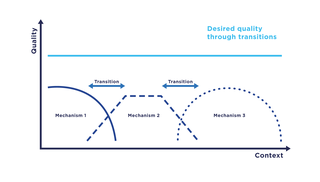Related Research Articles
In telecommunication, provisioning involves the process of preparing and equipping a network to allow it to provide new services to its users. In National Security/Emergency Preparedness telecommunications services, "provisioning" equates to "initiation" and includes altering the state of an existing priority service or capability.

Wireless communication is the transfer of information (telecommunication) between two or more points without the use of an electrical conductor, optical fiber or other continuous guided medium for the transfer. The most common wireless technologies use radio waves. With radio waves, intended distances can be short, such as a few meters for Bluetooth or as far as millions of kilometers for deep-space radio communications. It encompasses various types of fixed, mobile, and portable applications, including two-way radios, cellular telephones, personal digital assistants (PDAs), and wireless networking. Other examples of applications of radio wireless technology include GPS units, garage door openers, wireless computer mouse, keyboards and headsets, headphones, radio receivers, satellite television, broadcast television and cordless telephones. Somewhat less common methods of achieving wireless communications involve other electromagnetic phenomena, such as light and magnetic or electric fields, or the use of sound.
Vehicular communication systems are computer networks in which vehicles and roadside units are the communicating nodes, providing each other with information, such as safety warnings and traffic information. They can be effective in avoiding accidents and traffic congestion. Both types of nodes are dedicated short-range communications (DSRC) devices. DSRC works in 5.9 GHz band with bandwidth of 75 MHz and approximate range of 300 metres (980 ft). Vehicular communications is usually developed as a part of intelligent transportation systems (ITS).

Edge computing is a distributed computing model that brings computation and data storage closer to the sources of data, so that a user is likely to be physically closer to a server than if all servers were in one place. This often makes applications faster. More broadly, it refers to any design that pushes computation physically closer to a user, so as to reduce the latency compared to when an application runs on a single data centre.
Vehicular ad hoc networks (VANETs) are created by applying the principles of mobile ad hoc networks (MANETs) – the spontaneous creation of a wireless network of mobile devices – to the domain of vehicles. VANETs were first mentioned and introduced in 2001 under "car-to-car ad-hoc mobile communication and networking" applications, where networks can be formed and information can be relayed among cars. It was shown that vehicle-to-vehicle and vehicle-to-roadside communications architectures will co-exist in VANETs to provide road safety, navigation, and other roadside services. VANETs are a key part of the intelligent transportation systems (ITS) framework. Sometimes, VANETs are referred as Intelligent Transportation Networks. They are understood as having evolved into a broader "Internet of vehicles". which itself is expected to ultimately evolve into an "Internet of autonomous vehicles".
A wireless ad hoc network (WANET) or mobile ad hoc network (MANET) is a decentralized type of wireless network. The network is ad hoc because it does not rely on a pre-existing infrastructure, such as routers or wireless access points. Instead, each node participates in routing by forwarding data for other nodes. The determination of which nodes forward data is made dynamically on the basis of network connectivity and the routing algorithm in use.

Cloud computing is the on-demand availability of computer system resources, especially data storage and computing power, without direct active management by the user. Large clouds often have functions distributed over multiple locations, each of which is a data center. Cloud computing relies on sharing of resources to achieve coherence and typically uses a pay-as-you-go model, which can help in reducing capital expenses but may also lead to unexpected operating expenses for users.

Mobile technology is the technology used for cellular communication. Mobile technology has evolved rapidly over the past few years. Since the start of this millennium, a standard mobile device has gone from being no more than a simple two-way pager to being a mobile phone, GPS navigation device, an embedded web browser and instant messaging client, and a handheld gaming console. Many experts believe that the future of computer technology rests in mobile computing with wireless networking. Mobile computing by way of tablet computers is becoming more popular. Tablets are available on the 3G and 4G networks.
Mobile data offloading is the use of complementary network technologies for delivering data originally targeted for cellular networks. Offloading reduces the amount of data being carried on the cellular bands, freeing bandwidth for other users. It is also used in situations where local cell reception may be poor, allowing the user to connect via wired services with better connectivity.
Mobile Cloud Computing (MCC) is the combination of cloud computing and mobile computing to bring rich computational resources to mobile users, network operators, as well as cloud computing providers. The ultimate goal of MCC is to enable execution of rich mobile applications on a plethora of mobile devices, with a rich user experience. MCC provides business opportunities for mobile network operators as well as cloud providers. More comprehensively, MCC can be defined as "a rich mobile computing technology that leverages unified elastic resources of varied clouds and network technologies toward unrestricted functionality, storage, and mobility to serve a multitude of mobile devices anywhere, anytime through the channel of Ethernet or Internet regardless of heterogeneous environments and platforms based on the pay-as-you-use principle."

Bernhard H. Walke is a pioneer of mobile Internet access and professor emeritus at RWTH Aachen University in Germany. He is a driver of wireless and mobile 2G to 5G cellular radio networks technologies. In 1985, he proposed a local cellular radio network comprising technologies in use today in 2G, 4G and discussed for 5G systems. For example, self-organization of a radio mesh network, integration of circuit- and packet switching, de-centralized radio resource control, TDMA/spread spectrum data transmission, antenna beam steering, spatial beam multiplexing, interference coordination, S-Aloha based multiple access and demand assigned traffic channels, mobile broadband transmission using mm-waves, and multi-hop communication.
Fog computing or fog networking, also known as fogging, is an architecture that uses edge devices to carry out a substantial amount of computation, storage, and communication locally and routed over the Internet backbone.
A cloudlet is a mobility-enhanced small-scale cloud datacenter that is located at the edge of the Internet. The main purpose of the cloudlet is supporting resource-intensive and interactive mobile applications by providing powerful computing resources to mobile devices with lower latency. It is a new architectural element that extends today's cloud computing infrastructure. It represents the middle tier of a 3-tier hierarchy: mobile device - cloudlet - cloud. A cloudlet can be viewed as a data center in a box whose goal is to bring the cloud closer. The cloudlet term was first coined by M. Satyanarayanan, Victor Bahl, Ramón Cáceres, and Nigel Davies, and a prototype implementation is developed by Carnegie Mellon University as a research project. The concept of cloudlet is also known as follow me cloud, and mobile micro-cloud.

Vehicle-to-everything (V2X) is communication between a vehicle and any entity that may affect, or may be affected by, the vehicle. It is a vehicular communication system that incorporates other more specific types of communication as V2I (vehicle-to-infrastructure), V2N (vehicle-to-network), V2V (vehicle-to-vehicle), V2P (vehicle-to-pedestrian), V2D (vehicle-to-device).

Transition refers to a computer science paradigm in the context of communication systems which describes the change of communication mechanisms, i.e., functions of a communication system, in particular, service and protocol components. In a transition, communication mechanisms within a system are replaced by functionally comparable mechanisms with the aim to ensure the highest possible quality, e.g., as captured by the quality of service.
Cellular V2X (C-V2X) is a 3GPP standard for V2X applications such as self-driving cars. It is an alternative to 802.11p, the IEEE specified standard for V2V and other forms of V2X communications.
5G network slicing is a network architecture that enables the multiplexing of virtualized and independent logical networks on the same physical network infrastructure. Each network slice is an isolated end-to-end network tailored to fulfill diverse requirements requested by a particular application.

An Aerial base station (ABS), also known as unmanned aerial vehicle (UAV)-mounted base station (BS), is a flying antenna system that works as a hub between the backhaul network and the access network. If more than one ABS is involved in such a relaying mechanism the so-called fly ad-hoc network (FANET) is established. FANETs are an aerial form of wireless ad hoc networks (WANET)s or mobile ad hoc networks (MANET)s.
In telecommunications, 6G is the designation for a future technical standard of a sixth-generation technology for wireless communications.

Ashutosh Dutta is a computer scientist, engineer, academic, author, and an IEEE leader. He is currently a Senior Scientist, 5G Chief Strategist at Johns Hopkins University Applied Physics Lab, APL Sabbatical Fellow, Adjunct Faculty and Director of the Doctor of Engineering Program at Johns Hopkins University. He formerly served as the ECE Chair for EP at Johns Hopkins University. He is the Chair of IEEE Industry Connection O-RAN Initiative and the Founding Co-Chair for the IEEE Future Networks Initiative. He also serves as the co-chair for the IEEE 5G/6G innovation Testbed.
References
- ↑ "Multi-access Edge Computing (MEC)". ETSI. Retrieved 25 April 2021.
- ↑ Garvelink, Bart (14 Jul 2015). "Mobile Edge Computing: a building block for 5G". Telecompaper.
- 1 2 Ahmed, Arif; Ahmed, Ejaz (2016). "A survey on mobile edge computing". 2016 10th International Conference on Intelligent Systems and Control (ISCO). pp. 1–8. doi:10.1109/ISCO.2016.7727082. ISBN 978-1-4673-7807-9. S2CID 2823865.
- 1 2 3 "Mobile Edge Computing Introductory Technical White Paper" (PDF). etsi.org. 2014-09-01. Retrieved 2015-10-26.
- ↑ Dyer, Keith (23 February 2015). "On the edge: the story of Mobile Edge Computing". The Mobile Network.
- ↑ Vermesan, Ovidiu; Friess, Peter (16 June 2015). Building the Hyperconnected Society: Internet of Things Research and Innovation Value Chains, Ecosystems and Markets. River Publishers. pp. 65–. ISBN 978-87-93237-99-5.
- ↑ David Anderson (11 June 2015). A Question Of Trust. Lulu.com. pp. 54–. ISBN 978-1-326-30534-5.
- ↑ Abbas, N.; Zhang, Y.; Taherkordi, A.; Skeie, T. (February 2018). "Mobile Edge Computing: A Survey". IEEE Internet of Things Journal. 5 (1): 450–465. doi:10.1109/JIOT.2017.2750180. hdl: 10852/65081 . S2CID 31429854.
- ↑ Mach, P.; Becvar, Z. (2017). "Mobile Edge Computing: A Survey on Architecture and Computation Offloading". IEEE Communications Surveys & Tutorials. 19 (3): 1628–1656. arXiv: 1702.05309 . doi:10.1109/COMST.2017.2682318. S2CID 6909107.
- ↑ Sanchez-Iborra, Ramon; Sanchez-Gomez, Jesus; Skarmeta, Antonio F. (2018). "Evolving IoT networks by the confluence of MEC and LP-WAN paradigms". Future Generation Computer Systems. 88: 199–208. doi:10.1016/j.future.2018.05.057. S2CID 52121101.
- ↑ "Multi-access Edge Computing (MEC)". Nokia. Archived from the original on 2018-11-22.
{{cite web}}: CS1 maint: unfit URL (link) - ↑ Shi, W.; Cao, J.; Zhang, Q.; Li, Y.; Xu, L. (October 2016). "Edge Computing: Vision and Challenges" (PDF). IEEE Internet of Things Journal. 3 (5): 637–646. doi:10.1109/JIOT.2016.2579198. S2CID 4237186.
- ↑ Nguyen; Le (2020). Joint Computation Offloading, SFC Placement, and Resource Allocation for Multi-Site MEC Systems. WNCN2020. Seoul: IEEE. pp. 876–880. arXiv: 2003.12671 . doi:10.1109/WCNC45663.2020.9120597.
- ↑ Santa, Jose; Fernandez, Pedro J.; Ortiz, Jordi; Sanchez-Iborra, Ramon; Skarmeta, Antonio F. (2018). "Offloading Positioning onto Network Edge". Wireless Communications and Mobile Computing. 2018: 1–13. doi: 10.1155/2018/7868796 .
- ↑ Satyanarayanan, M. (January 2017). "The Emergence of Edge Computing". Computer. 50 (1): 30–39. doi:10.1109/MC.2017.9. S2CID 12563598.
- ↑ Hardesty, Linda (9 September 2015). "Mobile Backhaul Takes a Page from Cloud Computing". SDX Central.
- ↑ "AWS Wavelength Deliver ultra-low latency applications for 5G devices". AWS Wavelength Deliver ultra-low latency applications for 5G devices. Amazon Web Services. Retrieved 28 January 2021.
- ↑ Portal, ETSI. "List of Members". portal.etsi.org. Retrieved 2016-09-19.